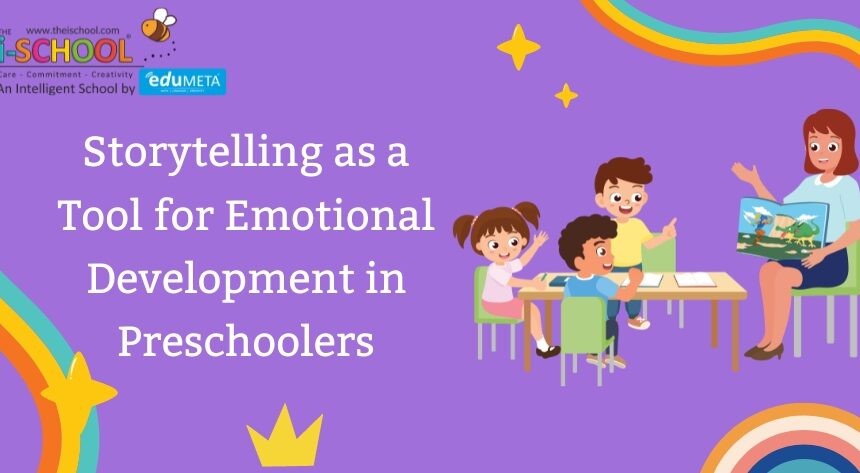Storytelling as a Tool for Emotional Development in Preschoolers

Storytelling has been a fundamental part of human culture for centuries, passing down wisdom, morals, and traditions from one generation to the next. For preschoolers, storytelling is more than just a way to entertain or educate; it’s a powerful tool for emotional development. Through the art of storytelling, young children can learn to understand and manage their emotions, develop empathy, and build resilience.
The Emotional Benefits
Understanding Emotions
Stories often involve characters experiencing a wide range of emotions, from happiness and excitement to sadness and fear. When preschoolers listen to these stories, they begin to recognize and label these emotions in themselves and others. This understanding is the first step in helping children manage their feelings in a healthy way.
Building Empathy
Storytelling allows children to step into the shoes of different characters, experiencing the world from various perspectives. This helps them develop empathy, as they learn to understand and share the feelings of others. For example, when a story’s protagonist feels scared or lonely, preschoolers can relate these feelings to their own experiences, fostering a deeper sense of empathy.
Developing Problem-Solving Skills
Many stories revolve around a problem that needs to be solved, whether it’s a lost toy, a friendship challenge, or a difficult journey. As preschoolers follow the characters’ journeys, they learn that challenges can be overcome and that there are different ways to solve problems. This builds resilience and encourages creative thinking when faced with their own difficulties.
Expressing Emotions
Through storytelling, children are given a safe space to express their own emotions. Whether they are recounting a personal experience or creating a fictional story, storytelling allows them to explore and articulate their feelings. This can be particularly helpful for children who struggle to express themselves verbally.
Managing Fears and Anxieties
Stories can address common fears and anxieties that preschoolers face, such as fear of the dark, starting school, or making new friends. By hearing how characters in stories confront and overcome their fears, children can gain the confidence to face their own anxieties. Stories that include elements of magic or fantasy can also provide a sense of escape and comfort.
Creating Emotional Connections
When children listen to or share stories with caregivers, teachers, or peers, they form emotional bonds. These connections are crucial for a child’s sense of security and belonging. The shared experience of storytelling strengthens relationships and provides a foundation of trust and communication.
Practical Ways to Use Storytelling for Emotional Development
Choose Emotionally Rich Stories
Select stories that deal with a variety of emotions and situations that preschoolers can relate to. Books that address themes like friendship, kindness, and dealing with difficult emotions can be particularly effective. Consider stories that include clear examples of characters experiencing and coping with different emotions.
Encourage Participation
Involve preschoolers in the storytelling process by asking open-ended questions about the story, such as “How do you think the character feels?” or “What would you do in that situation?” This encourages children to think critically about emotions and situations, helping them to develop their emotional vocabulary.
Use Storytelling as a Reflection Tool
After reading a story, encourage children to reflect on their own experiences related to the emotions or situations in the story. For example, after a story about a character who feels sad, ask the child if they’ve ever felt sad and what made them feel better. This reflection helps children process their own emotions.
Incorporate Storytelling into Daily Routines
Make storytelling a regular part of your daily routine, whether it’s during circle time at preschool, before nap time, or at bedtime. Consistent exposure to stories provides continuous opportunities for emotional learning and development.
Create Opportunities for Children to Tell Their Own Stories
Encourage preschoolers to tell their own stories, whether they are based on real-life experiences or their imagination. This allows children to explore and express their emotions in a creative and non-threatening way. You can use prompts like “Tell me about a time when you felt really happy” or “What would you do if you were a superhero?”
Use Puppets or Props
Incorporating puppets or props into storytelling can make the experience more interactive and engaging for preschoolers. Children often find it easier to express emotions through a character or puppet, which can lead to more open discussions about feelings.
Storytelling Through Art
Sometimes, children express their understanding of a story or their own emotions better through drawing or crafting. After a storytelling session, provide materials for children to create pictures or crafts that represent the emotions or events in the story. This can help solidify their understanding and provide another outlet for emotional expression.
The Lasting Impact of Storytelling
By incorporating storytelling into early childhood education, you are providing preschoolers with a vital tool for emotional development. The lessons learned through stories—about emotions, empathy, and problem-solving—can have a lasting impact on their social and emotional growth. As children navigate the complexities of their own feelings and relationships, the stories they’ve heard and told will serve as a guide, helping them to better understand themselves and the world around them.
Conclusion: Storytelling as an Emotional Growth Tool
Storytelling is more than just a way to entertain preschoolers; it’s a powerful tool for nurturing emotional intelligence. By carefully selecting stories, engaging children in discussions, and encouraging them to tell their own stories, parents and educators can help preschoolers develop the emotional skills they need to thrive. These early experiences with storytelling lay the foundation for a lifetime of emotional health and well-being.
